Please call the Coordinator at 617-732-6600 or submit a request through our secure online form.
If you are interested in sharing your story, please email us at bwhnsusocialmedia@partners.org.
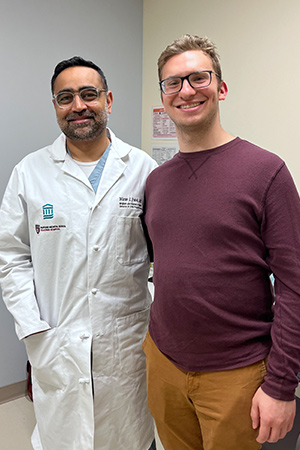
Joshua Banner, a 23-year-old student at the University of North Carolina, Chapel Hill, embarked on a remarkable journey of self-discovery and healing. Amidst the challenges of navigating a diagnosis of an Arteriovenous Malformation (AVM) in the Right Occipital Lobe of his brain (bordering on visual cortex), Josh's path intersected with that of Dr. Nirav Patel, a beacon of hope and expertise in the field of neurosurgery. Through candid reflections and heartfelt accounts, Joshua and his mother, Amanda, invite us into their world, sharing the highs and lows of their transformative journey.
From the initial uncertainty and fear to the decisive moments of hope and determination, their story resonates with the universal themes of perseverance and the power of human connection.
Follow Joshua on his journey from diagnosis to finding treatment, undergoing surgery, and healing.
Joshua first experienced health issues when COVID-19 struck during his freshman year of college. Initially attributing his symptoms to anxiety, he later discovered he was actually suffering from partial seizures. These episodes manifested as loss of motor function, elevated heart rate, speech difficulties, and partial loss of vision. Joshua said, “I was mad at myself and was a tough self-critic because I struggled a lot in school. My grades declined as the health condition worsened and I judged myself immensely for that. My life was so amazing: I was at a great school, had great friends, a loving girlfriend, and I was the vice president of my fraternity — I had a fantastic base of support around me — the pieces of the puzzle didn't fit together, why was I struggling so much? There was something that needed to come to light.”
Joshua remained unaware of the underlying disease damaging his health, but he couldn't ignore the worsening symptoms. In October 2022, Joshua was driving when he began experiencing strange sensations — later identified as signs of a seizure — just 30 minutes into his 2.5 hour trip. Losing consciousness behind the wheel, he veered into oncoming traffic then crashed into a tree. Miraculously, he emerged with only a minor concussion, yet subsequent CT scans revealed nothing unusual.
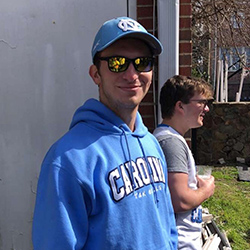
Labor Day weekend of 2023 marked a turning point in Joshua's life when he suffered a Grand Mal seizure. Regaining consciousness in the ambulance en route to the hospital, he had no recollection of the events that transpired. Despite undergoing a second CT scan that showed normal results, the ordeal left him bewildered.
Amanda, Joshua’s mother, and a physician herself, reveals that aside from the Grand Mal seizure, none of his other symptomatic episodes were witnessed. Fainting episodes, attributed to vasovagal incidents, were not uncommon in the family and Josh had experienced them since childhood. However, following the Grand Mal seizure, Josh's parents decided it was best for him to return home to Philadelphia in order to pursue a more comprehensive medical work up.
Amanda recounted her emotional journey upon receiving her son’s diagnosis. Initially grappling with the news of his seizure disorder, she found it difficult to come to terms with the situation. However, within a mere 48 hours of learning that, all along, Joshua’s “episodes” were seizures, their understanding took a drastic turn. Just two days after being home, an MRI revealed an AVM and evidence of a brain hemorrhage, a revelation that added complexity and urgency to their search for effective treatment. They were no longer looking at a seizure condition, but the diagnosis of a cerebrovascular disease.
Blessed with parents who are physicians, Joshua had access to a wealth of connections in the medical field. Most of them advised against a surgical approach and recommended that Joshua undergo radiation therapy. A few of the doctors were willing to perform open surgery to remove his AVM, but could not assure Joshua that he wouldn’t lose up to half his vision. A neuro-ophthalmologist advised Joshua that if that occurred, he would not be able to drive and could have significant difficulty reading and navigating through space for the rest of his life. As a 23-year-old college student, the prospect of such a loss was daunting. Unable to drive, read, or engage in many typical activities, Joshua faced the possibility of profound limitations that would greatly impact his daily life.
The initial advice that Joshua received from several doctors was disheartening. Driven by a conversation with his cousin, however, Joshua found inspiration to persevere: “It gave me the strength and courage to think maybe I shouldn’t listen to the first doctor or even the first few doctors or options. Why not see if there are other things out there that can help me more.” As an economics major with a background in data science, he approached most decisions analytically, recognizing the potential risks and benefits. Despite the logical appeal of less invasive options, such as radiation therapy, Joshua held onto the belief that there was a surgeon out there who could offer him the help he needed.
“The journey we went on to find Dr. Patel included seeing 11 other doctors” says Joshua. On their first meeting, Dr. Patel explained that the special surgical technique would allow him to resect Joshua’s AVM without damaging any healthy brain tissue and therefore preserve his vision.
Joshua expressed unwavering confidence in his decision to choose Dr. Patel for his surgery. Driven by Dr. Patel's meticulous attention to detail and his ability to address all concerns raised by Joshua and his family, Joshua felt reassured. Reflecting on his initial skepticism, Joshua acknowledged that Dr. Patel's exceptional qualities surpassed mere competence. Beyond his analytical prowess and effective communication, Dr. Patel also established a genuine emotional connection, earning his trust on a personal level. Joshua says, “It felt like Dr. Patel genuinely cared about me holistically as a person — he wanted to get to know me and wasn’t taking anything lightly by joking around and having social time, but he wanted to make me feel comfortable. On top of that, he was the only doctor that gave me every possible reason to believe that surgery would go the way I wanted it to go.”
Joshua believed that any alternative would pale in comparison, Dr. Patel was a “needle in a haystack in the field of neurosurgery.” Following their initial meeting, Joshua was unequivocal in his conviction: "That's my guy, no one else even came close." Amanda recounted that Joshua’s clarity and courage arrived before the rest of the family. They were anxious to have Joshua undergo an approach that no other surgeons were using. Joshua vividly recalls the “magical moment” after their third meeting when his whole family unanimously agreed that Dr. Patel was the ideal surgeon for his case. The collective relief and positivity that permeated the room affirmed their decision. Amanda gives her son credit for coming to his conclusion early on: Dr. Patel’s unique method wasn’t a reason to be scared, but rather the opposite, it was precisely the reason to choose him.
Following their decision, Joshua and his family encountered very few roadblocks. Within two weeks, they had a surgery booked and began preparations to temporarily relocate to Boston. They were fortunate to receive assistance from a nonprofit called Hospitality Home which provided housing for individuals requiring an extended stay in a different location after surgery. This support helped alleviate some of the logistical challenges associated with their upcoming journey.
On the day of surgery Joshua felt “very at peace.” As he waited, he engaged in deep introspection, contemplating the impact of his existence and envisioning a future world without him. Watching the movie It's a Wonderful Life provided him with solace and a renewed sense of purpose. Joshua says, "After grappling with the purpose of life and why I feel like I am on the earth — my meaning, what I can provide to people, and what I can add to society — how I could heal the world really speak true to me." He continues, "It's also something I think Dr. Patel really feels the same way about. We talked about his experience with the Peace Corps, and his mission, explaining the dedication to his work, and it was really something that I took to heart. In a lot of ways, it brought me through the process of that morning thinking, and relying back on those things made me feel at peace."
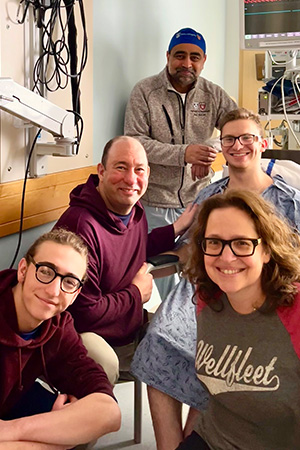
The day after surgery Josh was fully alert, sitting in a chair and had the same visual function that he came in with. Amanda, expressed, "Without trying to sound melodramatic, we felt like we were part of a miracle that only Dr. Patel could have provided. Not only in terms of his technical skill but his humanitarian connection with us and with the world." Joshua says his experience at Brigham was characterized by the exceptional care and warmth shown by every individual he encountered, contributing to an overall positive and memorable experience. "Every single person I met at Brigham, from the receptionist to the different nurses, to people reading labs, even the other patients — every single experience was incredible," Joshua enthused.
As we sat down with Joshua two months post-operation, eagerly anticipating his return to school in six months, we asked him what advice he has for patients who find themselves in similar situations. Joshua reflected on his journey and shared, “There is always a solution to a problem. Just keep going and keep looking until you find something that will really help you.” His words encapsulated the essence of perseverance and determination in the face of adversity, reminding others to remain steadfast in their pursuit of solutions and to take action even when it feels challenging. Additionally, Joshua says, "Allow all your emotions to come out. It's important to lean on others for strengths you don't have.”
When asked about her advice to caregivers in a similar situation, Amanda highlighted the importance of setting clear roles and creating a dynamic that works for your family's unique circumstances. Joshua and Amanda emphasized the importance of entering appointments ready with questions and research. They shared that ultimately, being prepared and knowing the type of care they were seeking helped them find their perfect match, and they couldn't be happier.
Two months after surgery, Joshua is flourishing and eagerly anticipating his return to North Carolina for his final semester of college. He is working as a Project Manager Intern at Centene Corporation, and is exploring his creative outlets by writing a newsletter on LinkedIn, playing music, and working on sports data science projects. Josh's future looks exceptionally bright, a testament to his determination and perseverance that led him to Dr. Patel, and a permanent cure for his dangerous and scary neurological and cerebrovascular disease.

In February of 2023, Steve Spitzer, Emeritus Professor of Sociology at Suffolk University, was diagnosed with Normal Pressure Hydrocephalus, an abnormal buildup of excess cerebrospinal fluid. He was operated on by Dr. Golby and wanted to share his experience with us in his own words. Note: this testimonial has been edited by Brigham and Women’s Neurosurgery Marketing Team for length.
Read Steve's testimonial below:
Reflections on My Very Own Big Dig
Popular culture of the last century offers us portraits of surgical experimentation with the brain that range from ghastly, to existential, to hilarious. However, my operation, as far as I can surmise, wasn’t anything like those performed on film by some of our comedy greats. Zany neurosurgeons like those depicted in the classic comedies Young Frankenstein (starring Gene Wilder in1974) or The Man with Two Brains (starring Steve Martin in1983), never showed up in the operating room that I was wheeled into. I’m also guessing that my surgery was much less dramatic and film-worthy than those with box office appeal, but since I ‘really wasn’t there,’ I couldn’t say for sure.
If we return from movies to reality for a moment, there was, indeed, a scientific explanation and rationale behind the procedure. It didn’t involve a taking away of offending parts (as medicine often likes to do) as was the case with lobotomies, but an adding in of a few shiny new whiz-bang “extra parts.” In this case, I was of course asked to sign all forms approving the installation of a device called a Codman Hakim Programmable Valve along with a ventriculoperitoneal cerebral shunt.
For the record, the “diagnosis,” and anyone who wants actual “treatment” and insurance coverage these days must have one, was “Normal Pressure Hydrocephalous”. NPH is a term you might hear in the Doctor’s lounge around lunch time, but not so much on the street. It refers to an increasingly recognized and understood condition that affects balance, gait, energy level, bladder function and who knows what else.
I am pleased to report that my story falls into the same category as the sky diver who when asked in mid-jump purportedly said: “so far so good.” As of this writing the story seems to have a happy ending. I’m now back in the swing of things with more energy, stability, and a new outlook on both Western medicine and my own aging process. I also feel blessed and fortunate in two respects: to be among the insured and to have had one of the very few operable conditions of the brain.
For me, the hospital experience was both larger and smaller than life, and in a sense, surreal. It had the quality of crossing a threshold into a non-ordinary world. At the outset, I felt like I was a passenger on the way to an unknown destination with unknown guides and drivers following newly unearthed maps. However, the biggest lesson in this entire experience, turned out to have more to do with trust and surrender than anything I could either extract from my experience or unravel with my analytical mind.
As much as I tried to make it so, this experience was not business as usual. There was nothing for my “mind” to decipher, decode or digest from either the future or the past. There was only one way to take this trip: in the “Now.”
My “big dig,” with all its attendant anxiety, anticipation, frustration, and discomforts, along with my accompanying narration, could not be found in the domain of my prefrontal cortex. The experience could not, therefore, be known before it was known; nor could it be neatly packaged and digested in retrospect.
Beyond what I have reported, you should also know that I worked before, during and after the operation, to leave my “professor/intellectual/critical, analytical, sad, shame-burdened, and fearful “parts” at the front door of the hospital. After a little coaching, those parts turned out to be quite willing to stay home and to be held and comforted by my “Higher Self” (substitute the term of your liking here). Accordingly, I could return and be welcomed by “the wise one” inside. (You can listen to this podcast episode where Steve is interviewed.)
Now, almost six months after the operation, the guy pictured in the hospital gown feels very fortunate to have had the opportunity to allow a team of surgeons to put me under, tinker around in my head and abdominal cavity for 3 hours and, in the process, install a remotely controlled and adjustable valve in my brain.
I want to offer blessings and the utmost respect to the surgical team headed by Dr. Golby, as well as all those who contributed to the diagnosis, as well as those involved with creating, testing, monitoring and installing the valve. I also remain deeply appreciative for the support I have received from my family and friends. Most of all, I want to acknowledge the power of what lies beyond my meager understanding: that which can neither be seen nor known—the spirit watching over me through it all.
When I’m not thinking in terms of fantasy or “science fiction,” I can appreciate how “normal” I now feel as excess fluid now moves through a shunt under my collar bone and drains into my abdomen to be reabsorbed into my system. Whatever images any of us may conjure up about brain surgery, for me this was indeed a miracle of modern science—a miracle for which I feel humbled and profoundly grateful.
—Steve Spitzer, 6 September 2023
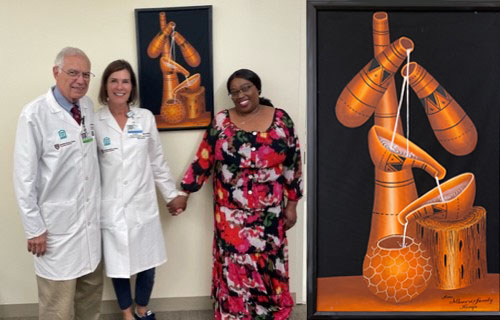
Pauline has been a patient of Dr. Laws for 11 years. Pauline met Dr. Laws in a difficult time in her life as her brother had recently died from a brain aneurysm. She had just been diagnosed with a pituitary tumor and was frustrated that symptoms of her tumor had continuously been dismissed and ignored by previous doctors. During a time where she didn’t have much hope, she met Dr. Laws who renewed her faith, telling her she was not going to die. This gave Pauline much reassurance and made her feel healed from having to burden her mother with the loss of another child.
Before Thanksgiving that same year, Dr. Laws completed a surgery on Pauline to remove her tumor. After her initial surgery in 2012, the tumor grew back and five years later she had a second surgery with Dr. Laws. Pauline believes that Dr. Laws has changed her life for the better. Her annual appointment with Dr. Laws and Shery Iuliano, NP is always something she looks forward to as the team is always “very encouraging.”
Dr. Laws gave Pauline a new chance at life and in return she gifted Dr. Laws a painting inspired by her renewed hope.
The painting, pictured above, is described as having two interpretations, one mimicking the functional pituitary processes with the flow of water between jars. The other is a Christian interpretation, ‘Whoever brings blessing will be enriched, and one who waters will himself be watered’ (Proverbs 11:25). Pauline believes that “people who are good and kind, always get good things and Dr. Laws is a good and kind man, and that is why he gets good things.”
Pauline and Dr. Laws have continued to have a great relationship and continue to send each other Christmas cards and handwritten letters every year. The picture above was taken at her recent follow up appointment, five years after the second surgery.
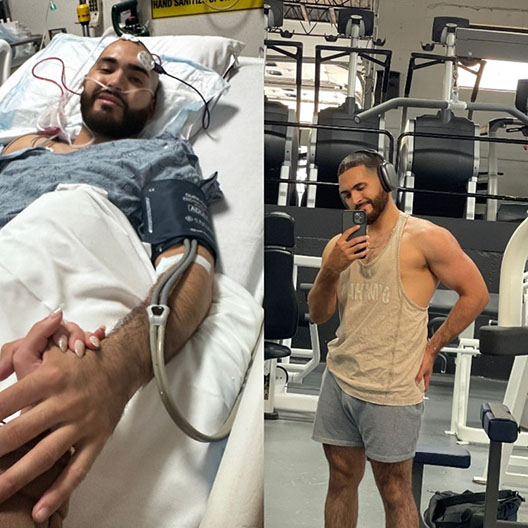
Eric Romero, pictured above, is a 25-year-old male who underwent a traumatic fall in March of 2023. He was life-flighted to our Emergency Department where he had a right hemicraniectomy surgery with Dr. Arnaout, and later placed into a coma for ten days. After waking up from the coma, Eric remembers being worried that he couldn’t walk or go to the gym again. He was concerned that he would lose everything and may not be able to go back to work. For these reasons and being just 5 weeks out from a bodybuilding competition when his accident happened, he was determined to get back to his active self.
While being at Brigham and Women’s Hospital for two weeks and at Spaulding Rehabilitation Center for three weeks, Eric began walking on his own after only a week and a half of using a wheelchair. He also had to wear a helmet for his brain injury, which he did not like and caused people to stare. For anyone that must wear one of these, Eric shares that "it is temporary and will go away, at the end of the day it is your story."
During such a frustrating and unfamiliar time, he relied heavily on his family and friends to recover from his injuries and recommends that others in his position, "seek motivation even when it’s not around." Family was a major part in Eric’s ability to recover, especially his fiancé, whose voice was the only one Eric would respond to when in his coma. He learned that it is important to be vulnerable, honest, and to seek help if you need it, especially in times of traumatic health.
Today, just 4 months post-traumatic fall, Eric feels like himself again. He expressed that he learned a lot about himself throughout this experience and hopes to share with other people in the same situation. He recommends for anyone worrying about the financial concerns that accidents and surgeries bring, to create a GoFundMe page, as this helped him and his fiancé greatly and allowed him to focus solely on recovery. A month ago, Eric had a cranioplasty procedure done by Dr. Arnaout where a 3D printed skill was placed onto his head, making him much more comfortable. He is now able to drive a vehicle, hit the gym again, and is looking to share his story to help people overcome a trauma like he did.
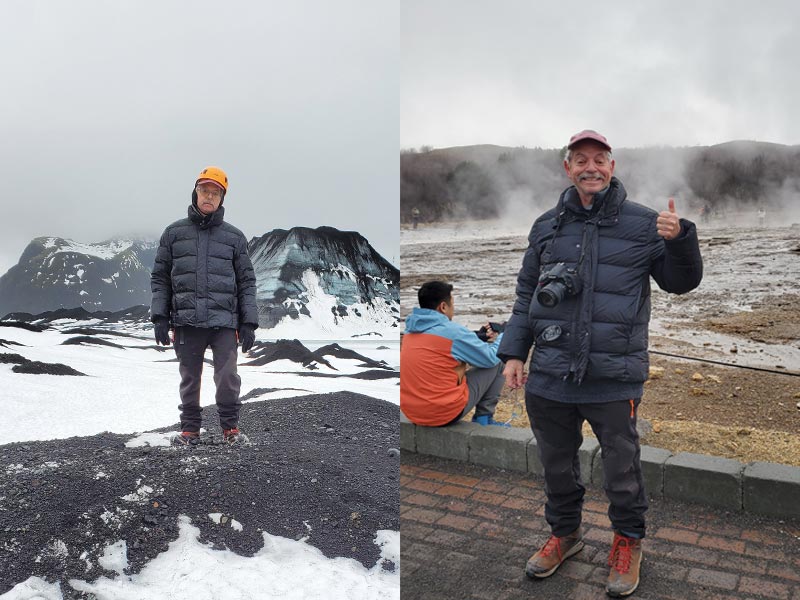
In April 2022, Richard Wayne was diagnosed with Normal Pressure Hydrocephalus (NPH). NPH is a brain disorder in which excess cerebrospinal fluid accumulates in the brain’s ventricles, causing disruptions to everyday functioning. Although skeptical to undergo surgery at first, Dr. Golby and her team made him feel safe and performed a life changing Ventriculoperitoneal Shunt Placement. Richard reached out to share his story in hopes to reach other future patients:
I want to share my personal journey and experience with undergoing surgery for Normal Pressure Hydrocephalus (NPH) in the hopes it may offer valuable insights for those considering a similar path.
Allow me to introduce myself - I am Richard Wayne, a 70-year-old man, who until recently enjoyed a relatively healthy and active lifestyle. Engaging in activities like hiking, traveling, walking my dog, and attending family events were integral parts of my life. However, approximately five years ago, I began noticing troublesome changes in my physical and cognitive abilities.
The simple act of walking became a challenge as I shuffled my feet and I struggled with balance. I fell more than once hampering my confidence. Cognitive issues such as clouded thinking and poor short-term memory compounded my difficulties. I was often confused. A loss of bladder control, particularly upon standing from a seated position, added to my frustration. I exercised five days a week with absolutely no improvement. Following visits to multiple neurologists, I was eventually diagnosed with NPH in April 2022.
The recommended course of action was surgery involving the insertion of a shunt device in my skull. This device was designed to alleviate my symptoms by draining extra cerebrospinal fluid to my abdomen. I was extremely hesitant fearing the surgery would not achieve its goals and perhaps I would be worse.
A turning point came during an overseas family vacation in August 2022. I struggled to keep up while walking (even with the help of a walking stick) and I faced the constant fear of falling. My family was alarmed by my condition and often sat me in a wheelchair. I realized the impact of NPH was rapidly interfering with and deteriorating my quality of life. Upon returning home, I made a decision to proceed with the surgery.
In mid-September 2022, I underwent surgery and the immediate post-surgery results were astounding. My balance was considerably improved, and I could walk without the previous shuffle in my gait. It was evident that my thinking had become clearer. My memory showed a significant improvement, and my bladder control was recovering. The transformation was so profound that both my family and friends were astonished by the overnight changes.
I had a renewed sense of confidence. I now walk my dog without fear of falling. I go to the gym which has shown immediate results; my leg strength continued to improve. By February 2023, I traveled with my wife to Iceland which a few short months ago would have been impossible. Walking on glaciers and exploring ice caves was like a dream, especially considering the five-year ordeal I had been through. The transformation was nothing short of a miracle and I feel a new sense of purpose.
I know everyone’s condition and circumstances are different and results may vary. However, based on my experience, I highly recommend considering surgery as a viable option to alleviate NPH symptoms.
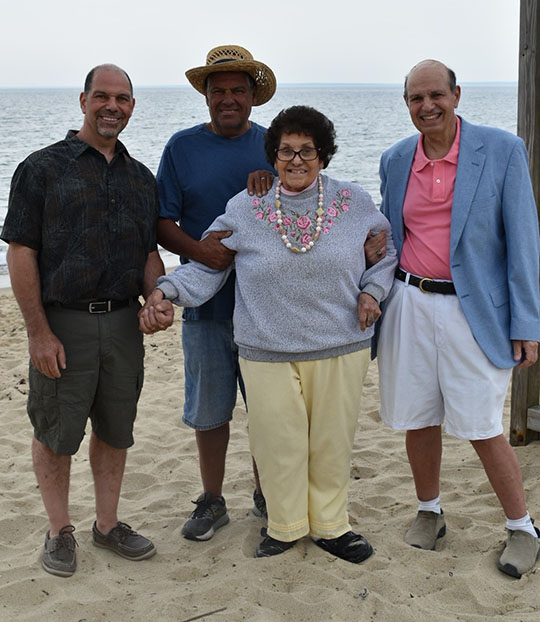
In March of 1999, Joseph C. Salvo, a 47-year-old computer teacher started to experience many strange symptoms. Over the following couple days, the symptoms became more frequent. Shortly after visiting his primary care provider, an MRI result revealed that Joseph had an orange-sized meningioma tumor in his brain that needed to be removed immediately. He was referred to Dr. Peter Black, a highly regarded Neurosurgeon-in-Chief at Brigham and Women’s Hospital in Boston. On March 23, 1999 he had an appointment with Dr. Black and scheduled surgery for the next day. Knowing that he would be operated on by the world-renowned Dr. Black made him and his family feel comforted during a time where everything else felt out of control.
The operation for the removal of the tumor took approximately 12 hours. The tumor started in his head, continued to his neck and then down to his spine. When it had nowhere else to grow it attached itself to the nerve in the right side of his head which controlled the left side of his body. There was nerve damage during the operation which left him totally paralyzed on the left side of his body and partially paralyzed on the right. During his first night post-surgery, Joseph became agitated and was diagnosed by Dr. Black as being in a steroid psychosis which caused significant lack of control.
Joseph’s care team in the rehabilitation home stated that he would never regain the ability to walk again. The doctor at the rehabilitation home was the most positive, stating that Joseph may possibly progress to walking with a walker at the age of sixty. Knowing this, Joseph became very determined to beat this and spent every waking moment trying to regain control of his body. Rehabilitative nurses suggested to Joseph that instead of setting a goal of walking again, he learn how to regain normal life functions from a wheelchair. Joseph disagreed and kept his sights on walking out of the rehabilitation home. He saw no other option and would do whatever he could to walk. On his second and third days of rehabilitation he was already taking inch size steps, where he quickly progressed from a wheelchair, walker, 4-legged cane, regular cane, brace, and then eventually nothing. This was deemed a miracle, one that his doctor explained as “totally and medically impossible”.
 With much effort and hard-work, Joseph is currently walking and enjoys all that life has to offer on his two feet. He still has repercussions and a slight limp, but “there is nothing that I don’t do, it just takes me a little bit longer” he says. Joseph enjoys golfing, going to the gym, and has dedicated much of his time to sharing his story and helping other people recover from brain surgery. I Wiggled My Toes… Hallelujah! was written by Joseph to share this story, which is sold on his website, eBay, Amazon, Barnes & Noble, as well as some bookstores on Cape Cod. He also has donated his book to every Library on Cape Cod. His best advice when going through something difficult is to simply trust yourself. Do not say “poor me” and let it ruin your life, your health, or your overall happiness. You have to be an advocate for yourself and realize that being diagnosed with a tumor can happen to anybody.
With much effort and hard-work, Joseph is currently walking and enjoys all that life has to offer on his two feet. He still has repercussions and a slight limp, but “there is nothing that I don’t do, it just takes me a little bit longer” he says. Joseph enjoys golfing, going to the gym, and has dedicated much of his time to sharing his story and helping other people recover from brain surgery. I Wiggled My Toes… Hallelujah! was written by Joseph to share this story, which is sold on his website, eBay, Amazon, Barnes & Noble, as well as some bookstores on Cape Cod. He also has donated his book to every Library on Cape Cod. His best advice when going through something difficult is to simply trust yourself. Do not say “poor me” and let it ruin your life, your health, or your overall happiness. You have to be an advocate for yourself and realize that being diagnosed with a tumor can happen to anybody.
Today, Joseph has helped individuals through their tough times and has done so by giving them hope when they cannot find any. He has walked three people through a brain tumor operation and is dedicated to helping many others. Whether it be personal connections, or through his book, Joseph has had a positive influence on many people and has guided them to change their perspective on the ability to overcome difficult situations. If you are looking for support and motivation to change your trajectory, Joseph C. Salvo could be your resource and is willing to lend a helping hand.
Website: www.josephcsalvo.com
“I have had seven brain surgeries and yes, they are scary but I've come out the other side of all seven better than I went in.”
—Sean Manning, patient
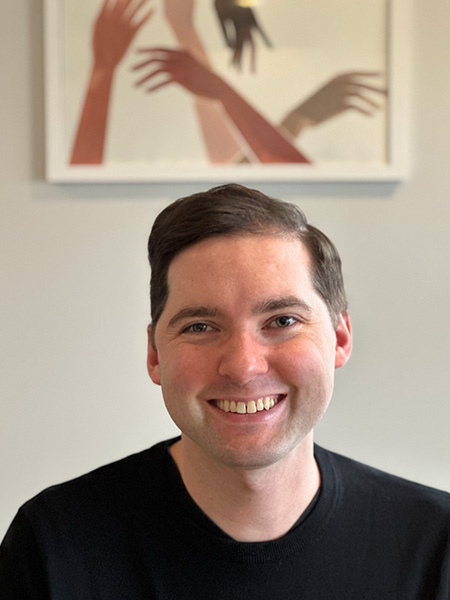
This patient feature recounts the captivating journey of Sean Manning (pictured 6 years after his surgery), a resilient survivor of an arteriovenous malformation (AVM) rupture, chronicling his journey from the onset of the rupture to his extraordinary recovery and eventual career trajectory. Drawing from an insightful interview, Sean generously shares the intricacies of his experience, ranging from the emergence of initial symptoms, the pivotal diagnosis, the ensuing treatment, and the triumphant recovery journey. Throughout his narrative, Sean's unwavering trust in his medical caregivers, coupled with his optimistic perspective and unyielding resilience, shines brightly, serving as a beacon of inspiration and counsel for those navigating similar adversities.
At 22 years old, Sean was on spring break during the final stretch of pursuing a master's degree in accounting. Amidst his break, dedicated as ever, he delved into preparation for his third CPA exam. Having successfully navigated all his midterms and conquered his second CPA exam just the week before, Sean's determination was unwavering. However, fate took an unexpected turn one Friday while he was at the gym.
"I came up from my ninth squat, 135lbs on my shoulders and it just burst," Sean recalled. It felt as though a water balloon had burst inside his head, a sensation unfamiliar to him. Despite the initial oddity, Sean pressed on, only to find himself losing control over the left side of his body as he made his way across the gym floor. "I started tripping over my left foot and then my left hand went numb and I couldn’t move it," he recounted.
Reaching a bench, Sean's last clear memory was of someone dialing 9-1-1 as he struggled to comprehend the unfolding events. Soon after, his consciousness faded, and he slipped into a coma. "I have one coma memory," Sean shared, "It felt like my dad was yelling at me, but he was, I'm sure, saying in an even toned voice, 'squeeze my hand with your right hand Seanie'."
In a marathon 10-hour surgery, Dr. Du's expertise was pivotal in saving Sean Manning's life during his stroke. Through meticulous procedures including a craniotomy, AVM resection, and precise vessel clipping, Dr. Du navigated the complexities of Sean's condition with skill and precision. Sean is forever grateful for her remarkable talent and commitment to his well-being.
Upon regaining consciousness, Sean was met with confusion and fear, questioning his surroundings and the sudden loss of mobility in his left side. Yet, with his family by his side, particularly his mother sitting with him in his hospital bed, Sean found solace amidst the uncertainty.
At Brigham and Women’s Hospital, Sean had to wait three weeks until the swelling in his brain subsided enough for Dr. Du to perform a critical cranioplasty. Following his surgery, Sean embarked on an intensive eight-week inpatient rehabilitation program at Spaulding in Charlestown where he relearned how to walk and regained basic motor skills in his left arm and hand.
Throughout his recovery journey, Sean credits the skill and care of Dr. Du, whose expertise not only facilitated his physical rehabilitation but also inspired him to pursue his academic goals. Sean, while in outpatient rehab completed his master’s program, despite the challenges. "I was super lucky though, I am sure this had to do with Dr. Du’s talent," Sean reflected, “I am sure partly, if not all, was due to Dr. Du’s skills in my brain”.
Reflecting on his experience, Sean offers invaluable advice to others facing similar challenges: trust in medical professionals and diligently adhere to their recommendations. He acknowledges the fear associated with surgery but emphasizes the transformative outcomes that can result from placing faith in the expertise of doctors. "To the people who know they have an AVM, just do everything the doctors tell you to do. Like absolutely everything," he advised. When asked what advice Sean had for patients who may be afraid he explained “I have had seven brain surgeries and yes, they are scary but I've come out the other side of all seven better than I went in”.
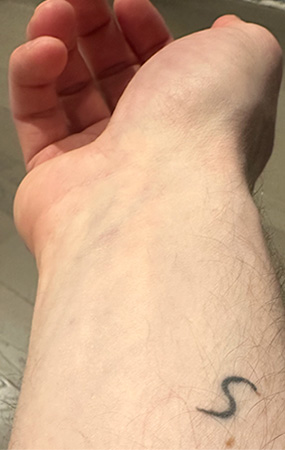
Seven years post-stroke, Sean has found fulfillment in an unexpected career path as a Career Coach at Genius Within, a UK-based company dedicated to neurodivergent awareness and empowerment. Despite the physical limitations imposed by his stroke, Sean's journey epitomizes resilience and post-traumatic growth, serving as an inspiration to others. When asked what some of his hobbies are, Sean responded, “So well, I can’t run but that's okay because running sucks.” He is a self-proclaimed “TV fanatic” and suggests to everyone reading that they should watch season one of “True Detective” with Matthew McConaughey.
Lastly, Sean shared the story behind his tattoo (pictured), which serves as a constant reminder of his resilience and inner strength. The tattoo, a simple "S" inked on his wrist, symbolizes his belief in himself as a superhero [Superman], capable of overcoming any obstacle. It serves as a powerful reminder not only to Sean but also to those around him facing similar challenges, that they possess a strength within themselves akin to that of a superhero.
“I remember Dr. Patel asking my husband, ‘Is she looking to be healed or does she want to be treated? If she is looking to be healed, I am her doctor.’ And that’s what he did. He lived up to what he said and I’m so thankful.”
—Jenn Murff, patient
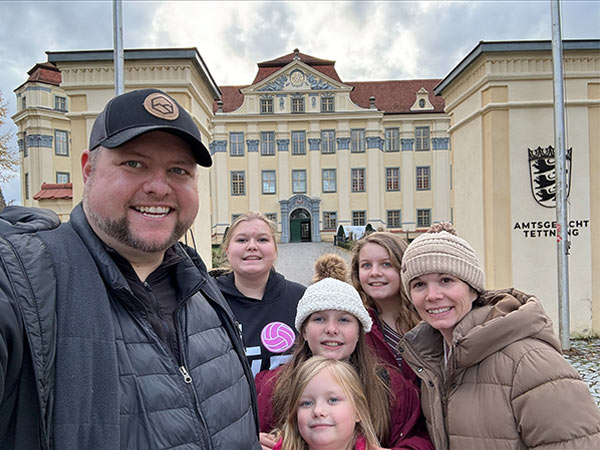
Jenn with her husband and four daughters (November 2023).
Jenn Murff is a wife, mom of 4 daughters, and the leader of a Christian ministries’ organization out of the greater middle east. Just over a year ago, she was speaking at a conference in Sweden when she got called up on stage to be recognized as one of the top future female leaders for ministry in the Middle East. As she walked off stage, she developed the worst headache she’d ever felt; however, she attributed it to adrenaline and carried on with her trip.
Upon returning home with a worsening headache, Jenn’s husband and mother-in-law rushed her to the emergency room. After many tests and scans, Jenn was diagnosed with a grade-5 arteriovenous malformation (AVM). Jenn immediately began seeking out the best care she could find. She met with numerous specialists at the top medical institutions in the country, almost all of them telling her that they anticipated a rupture but that her AVM was too large and complex to operate on. Jenn recalls her fear saying, “The thought of an imminent fatal rupture made me feel like I was wearing a bomb strapped to my head that could go off at any moment.” Despite receiving discouraging news time and time again, Jenn was determined to heal her brain: “My brain has always been the hallmark of my success…I’m a PhD, I communicate and use cognitive skills every day in my job. So, it was very scary to trust anyone with the very thing that I value on a human level the most: my intellect.”
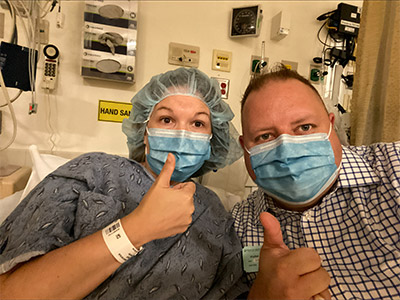
After almost two months of searching, Jenn came across Nicole Haight’s story on NBC Nightly News through the Brigham and Women's Patient Features. Nicole, an AVM patient, had been operated on and saved by Dr. Nirav Patel, director of the Brain AVM Program at Brigham and Women’s Hospital. Finding out that Nicole too was a wife and mother who was told by countless specialists that her AVM was inoperable, Jenn decided to reach out to her. Jenn and Nicole talked, and hearing that Nicole was healed and back to her former life, Jenn decided to reach out to Dr. Patel.
Jenn remembers the reassuring confidence of Dr. Patel saying he “immediately started connecting dots and making things happen. He and his team were completely open-handed.” Additionally, Dr. Patel understood why she wanted to take the risk of surgery and fight to get better, she said, “When I met with other institutions, number one, they didn’t have full confidence that they could do it. Number two, the other institutions that did say they would treat me never actually set up a time to connect with me as a person. Dr. Patel took a tremendous amount of time to have conversations to get to know me. I didn’t feel like just another a patient. I still remember he said, ‘I’m going to treat you because you are resilient, and I think you’re a fighter. There are things you want to live for.’” On August 8th, 2022, Jenn underwent her first surgery with Dr. Patel. Jenn’s AVM was complex, leading to a series of complicated surgeries in order to completely treat it. After 10 surgeries and many hours of physical therapy to re-learn to walk and talk, Jenn was healed.
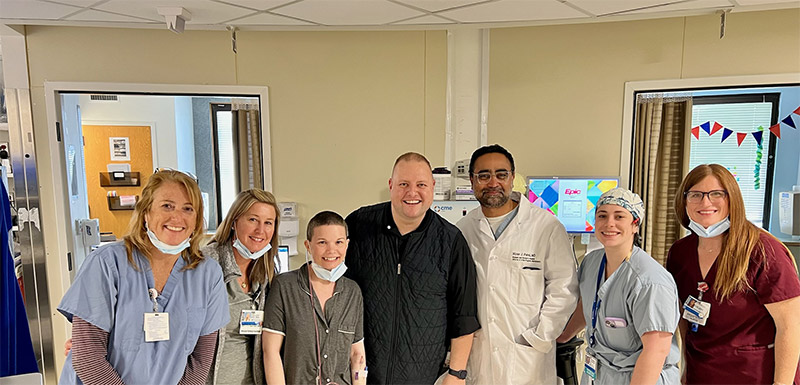
Jenn and her husband with Dr. Patel and her care team after her hydrocephalus shunt surgery.
When reflecting on her journey, Jenn wanted to express to other patients that it is ok if your healing journey doesn’t feel easy, in fact, it is okay if it’s “really, really hard.” But, more importantly, she wanted to emphasize that from where she stands now “it’s a journey she’d take a million times over.” When asked what helped her throughout her journey, Jenn highlighted the importance of having a strong support system saying, “The healing journey was difficult. And I hate to even say that because I want to say it was easy. But with the help of supportive and medical professionals who were there and present, I was okay. It’s very important that any patient has a good support system around them, whether its family or friends. I was lucky to have such a wonderful support system around me. My husband never left my side.”
Additionally, she stated the importance of Dr. Patel’s focus on “healing” rather than merely “treatment” saying, “What I love about Dr. Patel is that he told me, ‘Jenn, your physical healing is just the start.’ He let me know that there were things we were going to have challenges with both physically and mentally, but that we were going to fight to overcome them. He opened up doors to make sure I had all the care that I needed.”
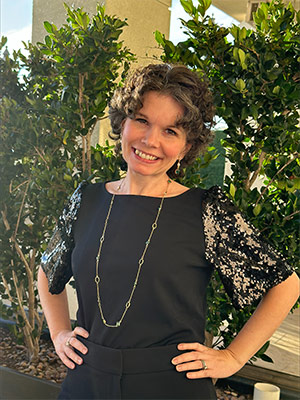
Lastly, Jenn wanted to give some advice to others who may find themselves in a similar position. First, she said, “Do your due diligence. Make sure you seek out the best of the best. Now I believe that the best of the best is Brigham and Women’s… Dr. Patel is the best surgeon in the world to have been able to treat my AVM!” For her second piece of advice, she shared, “Today, I talk with many other AVM patients prior to their surgeries, and I find that fear grips their hearts. I talk to patients that could be completely healed, but the thought of going into surgery paralyzes them. And so, I want them all to know that getting this surgery was the best decision that I have ever made. What do you have to be afraid of? Being cured will give you freedom! You’ve been bound to this disease and this fear, and now you get to be free. You don’t have anything to lose, just everything to gain.”
As we talked with Jenn in November of 2023, just 8 months after her final surgery, she has returned to working full time, being a full-time mom, and is heading on a three-week trip to Europe with her family – “a trip to mark the end of a tough chapter!” When signing off, Jenn added, “You guys truly changed my life. I’m able to do everything I did before. Brigham and Women’s team is by far the most loving, caring, and genuine team.”
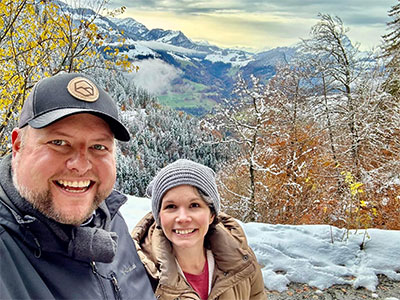
Jenn hiking the Swiss Alps post-operation!
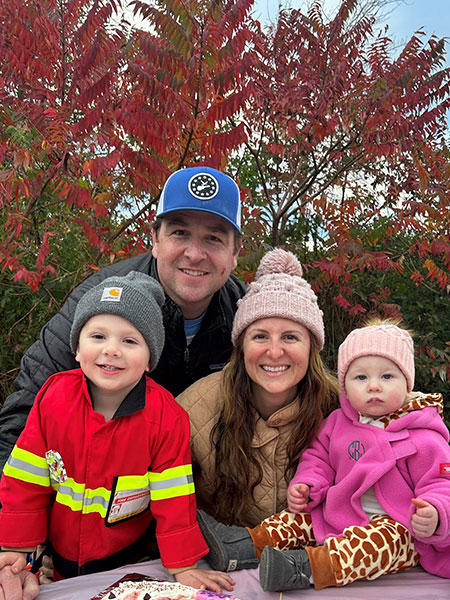
One night, Talia woke up to feed her 10-week-old daughter, only to find that the entire left side of her body was numb. When the numbness didn’t subside, she and her husband, Ryan, decided she should go to the emergency room. But being young, healthy, and busy parents-of-two, they weren’t too concerned and tried to maintain a typical day. Ryan dropped her off at their local emergency room so that he could bring their son to school and drop their daughter off with Talia’s mom. Although Talia was able to walk herself into the ER, it became clear that this may be more serious that she had thought. By the time Ryan got back to the hospital from dropping off the kids, Talia was told that she had a brain bleed.
Talia was then transferred to a different state hospital. They ran many tests; however, they couldn’t find a reason as to what caused the bleeding. Feeling unsettled without answers, Talia and Ryan sought out a second opinion. They saw a Brigham neurologist, Dr. Roy, who then referred them to Dr. Nirav Patel.
Talia describes meeting Dr. Patel as “a blessing.” She said, “Our first appointment he deep dove into everything, explaining things that were never explained like why I was never numb on my face or my arm because of the way in which the bleed happened. He made us feel very
comfortable in the way he approached what was going on. It’s the brain, it’s so complicated. But leaving the meeting, we felt like… we were experts on what was going on.” Although they would still need an angiogram to confirm, Talia remembers Dr. Patel saying, “I have a strong feeling about what this is and we’re going to fix it and we’re going to get you on with your life.”
The angiogram confirmed that Dr. Patel was right. Talia had been born with an Arteriovenous Malformation (AVM); however, she never knew about it because it had never caused any symptoms until then. Talia said Dr. Patel pulled out images and showed her exactly what his plan was. She emphasized the value in these conversations with Dr. Patel saying, “I think as I’ve been processing things, what I realized is that it was so comforting that Dr. Patel and his team humanized everything. That was really important. Because things move fast, there’s a lot of information and steps that need to be taken. The team was just world class.”
On Tuesday, February 21st, Dr. Patel performed a successful surgery on Talia. She looked back on her speedy recovery saying, “I think also as a mom, you power through. I had surgery, I spent a day in the ICU, then I walked myself down to the Neuro floor,” she laughed, “I was discharged on Thursday, and I was sledding with my son by Friday. Which is not advised… I promise it was a very small hill! But my point being, my experience at Brigham was pretty amazing.”
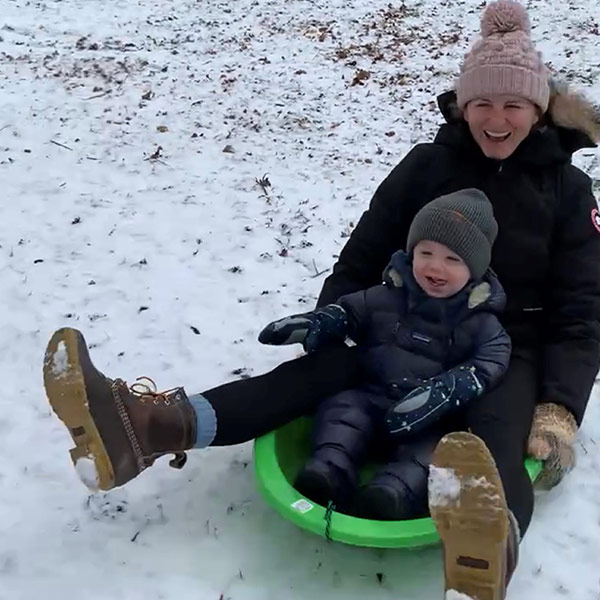
Today, Talia says she is feeling “great.” She is back to working full time as a strategist for an advertising agency and is kept busy with her now 2.5-year-old and one-year-old. She feels called to share her story and to bring more awareness to AVMs. She hopes that she can provide hope and comfort to others that may get a scary or unexpected diagnosis.
In sharing her story, Talia passed along a few pieces of advice from her experience. First, she said, “Ask a lot of questions and advocate for yourself. If you don’t feel like you have the answers you need, don’t be afraid to seek a second, third, fourth, or as many opinions as you need to find someone you trust.” Lastly, Talia emphasized the importance of prioritizing your emotional well-being throughout the process. She said it is crucial to have a support system – whether it be family, friends, or a medical team -- that will be there for you. Additionally, she said, “Make sure you feel the feelings. I remember many times at the end of it, I would just start crying and Dr. Patel would say ‘Talia, if you’re not crying in front of me than we may a bigger problem here. This is heavy stuff, big stuff, real stuff. Let’s feel all those emotions so you can heal.’” She said she is infinitely grateful that Dr. Patel not only ensured that she was healed surgically, but also emotionally so that she could return to her family, friends, work, and life.
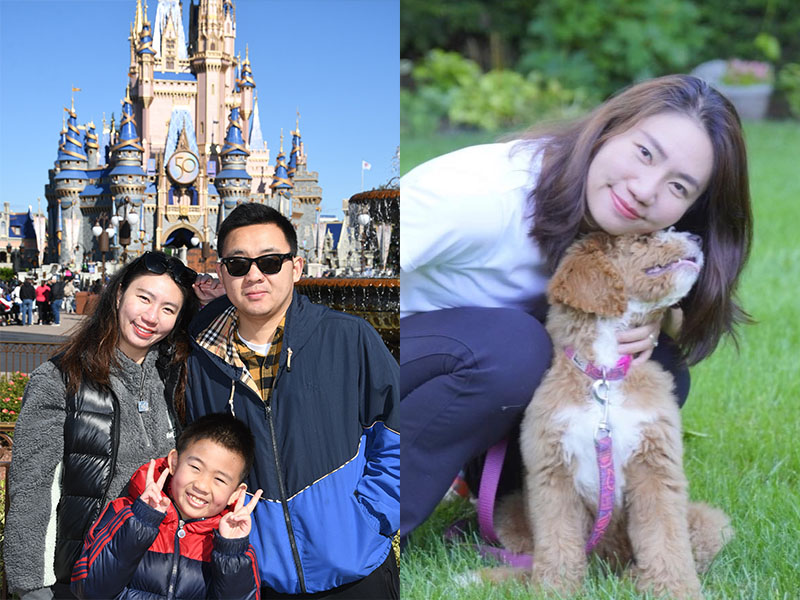
Although Luting Qiu doesn’t have many memories from the days surrounding her ruptured AVM, she does recall how lucky and touched she felt to have received great care by Dr. Patel and his team. Recently, we met with Luting to hear about her experience with an AVM and learn more about her life since she left Brigham and Women’s Hospital.
One night in September 2021, mother and former lawyer, Luting Qiu started having a bad headache. Throughout the night, her symptoms worsened. Her head pain became unbearable, and she began incessantly vomiting. By morning, Luting was in an ambulance headed to her local Mass General Brigham Hospital, Newton-Wellesley. Upon arriving at the hospital, it became clear that this was a more serious issue and that she would need to be transported to Brigham and Women’s Hospital in Boston. “When I needed surgery, we were so close to one of the best hospitals and some of the best doctors in the world. That may be the luckiest thing I’ve had happen in my life,” said Luting.
Luting recalls meeting Dr. Patel shortly after arriving at Brigham and Women’s. Luting was told that she had an Arteriovenous Malformation (AVM) – a tangle of blood vessels that interrupt blood flow and oxygen circulation in the brain – that caused vessels in her brain to rupture. He explained everything to her and her husband about her current situation, pulling up images of the vessels stuck together and showing them how he would repair it. Luting and her husband weren’t familiar with AVMs prior to her diagnosis, but it was clear that with time ticking, there wasn’t time for researching other options. She says she is so grateful that Dr. Patel was both “professional and confident,” as it allowed her and her husband to feel more comfort in a time where they had limited knowledge and control. Dr. Patel performed a successful Biparietal Craniotomy for Ruptured AVM.
Looking back on her experience, Luting says, “I was not lucky to have an AVM in my brain, but I feel that I am the luckiest person that I had Dr. Patel and his team and that everything went so well.” Today, she feels that “everything is great and back to normal” as she is back to a busy life, helping her son with many everyday activities like tennis, piano, violin, math, swimming, and homework. She hopes that with her story, others can be encouraged that the surgery is worth it and that she is proof that you will be able to return to your former lifestyle.
Most importantly, Luting wanted to express how moved she was by her experience. First, she was grateful for Dr. Patel’s skills saying, “He is experienced. He is truly the expert in this area. I feel so lucky to have been seen by him. I remember at that time, I thought… what if I didn’t have Dr. Patel and I had a different doctor that may have done something wrong. I may have been alive but maybe lying in a bed forever. That would have been a disaster for my family. I am so lucky that I had the right team and doctor.” Next, she commended his positivity and humbleness. She recalls right after surgery when she felt concern about not having much memory of any of her time in the hospital. Dr. Patel reassured her saying, “It’s ok. You don’t need to remember the bad memories. Now you only have to focus on the good memories going forward.” Additionally, she recalls that each time she thanked Dr. Patel, his immediate response was to make sure she knew it was the whole team and that they all worked closely together to make this successful. She was inspired by the support and help from the entire team of doctors, nurses, and staff.
Luting left off with sharing a few pieces of advice for others who may find themselves in her position: “Listen and trust your doctors. The surgery is totally worth it in my opinion. Life is so important. Go for the operation.”

Nicole Haight (pictured above with her family) is a patient of Dr. Nirav Patel, MD, Director of the Arteriovenous Malformation (AVM) program. Most importantly, Nicole is a mother, wife, and daughter whose life changed when diagnosed with an Arteriovenous Malformation (AVM). Nicole was told by several physicians that her condition was inoperable and that she needed radiation, offering a 40% chance of even touching the AVM before damaging bad tissue. After finally finding a doctor to operate, Nicole had a stroke which delayed her operation. She was sent home where her craniotomy procedure was rescheduled five times. At this point Nicole states that she “felt defeated” and couldn’t find much hope. She got her life insurance ready, her will, and wrote notes to her kids for all their big days. After years of searching for answers and seven doctors later, she found Dr. Patel.
After hearing about Brigham Women’s Hospital and Dr. Patel from a client at her job, Nicole had a call with Dr. Patel where he told her that her AVM was operable and that he could start treatment right away. Nicole describes Dr. Patel as a confident, and “different” kind of doctor that works with his patients and knew what was best for her. That following weekend Nicole and her mother drove 16 hours to Boston, MA. Shortly after arriving, she was admitted to BWH with symptoms of a bad headache and vomiting of blood. Nicole didn’t remember much until after she woke up from surgery.
Today, Nicole feels much better. She is taking her kids on vacations and using her time more wisely. “I owe everything to Patel and his team,” she stated, as she thought that her life was going to end before she met Dr. Patel. Nicole claims that this experience and diagnosis of an AVM was a blessing in disguise as, “you never think that something can happen to you”. She is now more health conscious because this experience opened her eyes to the fact that “you truly have one life, and it can end any second”. Nicole’s biggest advice to others is to not put your life into numbers, and advocate for yourself no matter how hard it is.
In this video created by the Focused Ultrasound Foundation, a patient of Brigham and Women's physician Rees Cosgrove, MD, with Parkinson's disease describes his life-changing focused ultrasound experience.
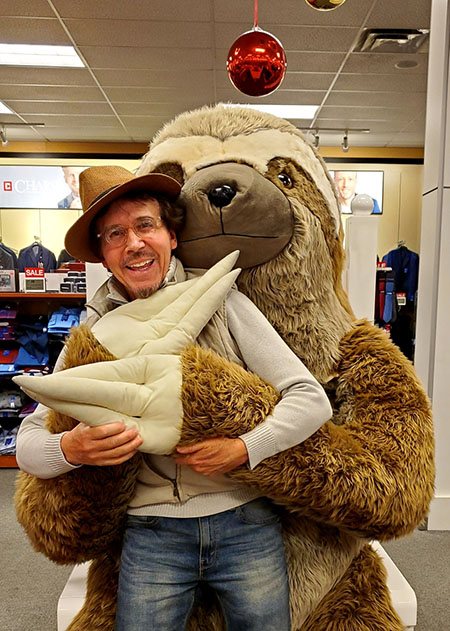
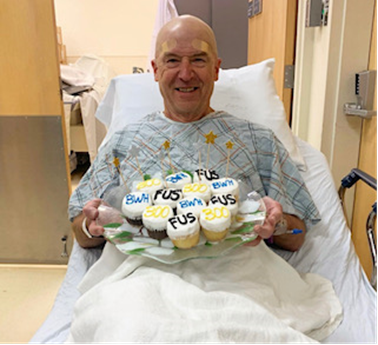
Kenneth Correll (pictured above), a patient of Dr. G. Rees Cosgrove, Director of Epilepsy and Functional Neurosurgery, recently underwent a milestone treatment known as a Focused Ultrasound (FUS); a non-invasive, highly therapeutic treatment technique. This was the 300th Focused Ultrasound to be performed by Dr. Cosgrove and his team at Brigham and Women’s Hospital.
The treatment is incision-free and often results in great therapeutic effect that involves minimal complications. Guided by real-time MRI, the treatment technique provides patient-specific treatment planning as well as continuous temperature monitoring. With great flexibility and the ability to adjust parameters to ensure optimal response, patients typically get to go home the very same day as their procedure.
Kenneth was able to celebrate with the team immediately after the treatment concluded. Dr. Cosgrove is Insightec’s 3rd site in the country to reach this milestone.
Gavin Davis, a 35-year-old father of two (with one more on the way!) has had quite the year in 2023. In February, he auditioned for a production of Rock of Ages. In March, he was cast as a lead in the show. And in April, he took a life-altering slip, ultimately ending him here at Brigham and Women’s Department of Neurosurgery.
In April 2023, Gavin and his wife went hiking in the Berkshires. When it started to rain, they decided to turn around and head back down the hill. With his wife being pregnant, Gavin decided to go first so that he could help her get down the hill; however, just as he began his descent, his left foot slipped, and he fell backwards. Gavin managed to get up and go home, attributing the intense pain in his neck merely to soreness. With no improvement by the next day, however, Gavin decided to drive himself to the nearest emergency room in hopes to get a muscle relaxer or pain reliever.
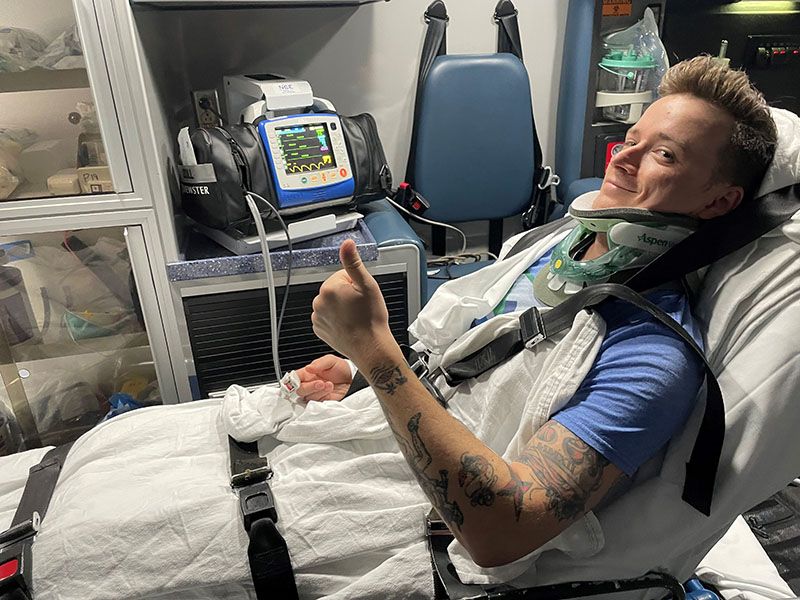
Upon arriving at the hospital, Gavin was given a CT scan to check for a fracture. However, after the scan he was told he would need an MRI. When the MRI was completed, he began to worry as the staff now wouldn’t let him walk on his own. The care team informed him that his C2 vertebra (the second vertebrae from the top of the cervical spine) may be fractured and that “there may be something else wrong, but they would need to refer him to another hospital.” Gavin recalls being told, “You’re getting in a helicopter and going to Boston.” Due to inclement weather, they ultimately decided it would be best to take an ambulance immediately instead.
Gavin arrived at Brigham and Women’s hospital where he would undergo five days of CTs, MRIs, and a biopsy. His care team discovered that there was never a fracture, but rather found an aneurysmal bone cyst, a rare, benign lesion in the bone that tends to expand and grow, causing bone deformity, pain, and fracture. Dr. Lu referred him to Dana Farber so they could begin to develop a plan to stop the growth of the cyst.
On August 4th, Gavin was able to perform in the opening night of Rock of Ages: “I can’t believe that 4 months ago I was in the back of an ambulance in a neck brace and now I’m on-stage doing rock and roll music.” When asked how he was feeling today, he said, “I feel so much better. I feel great. I have a path forward with a treatment plan and just received my first infusion today.”
Gavin gave two pieces of advice for those who may find themselves in a situation like his. First, he says, “Just go to the hospital. I waited 24 hours to go to the hospital. Don’t do that especially when it’s your head, your neck, or any major joint. Who knows how long it would’ve been before I found out and what size the cyst would have grown to and limited treatment options.” Second, he says, “When you’re in the hospital, don’t be intimidated. Don’t be afraid to ask what may feel like a dumb question. Be your own advocate, know what’s happening, know your options, and engage in a dialogue. It’s so important to understand your body and know that you’re doing what’s right for you.”
Lastly, Gavin shared a few shout-outs to the department. He said, “The nursing staff on the Neurosurgery floor is unbelievable. Not just in the quality of care that they give, but they would just come in and sit down and talk about how I was feeling, both physically and mentally. Especially after visiting hours, your people aren’t there anymore and its lonely and you’re sort of scared. The care that goes beyond the boxes they have to check to do their job was just incredible. The residents and staff, in a very confusing time, were giving me all the information, they had at every point. They were so reassuring in just hearing me out. The incredible detail coming form the physicians involved was really comforting.”
 Gavin Davis performing on stage in Rock of Ages
Gavin Davis performing on stage in Rock of Ages
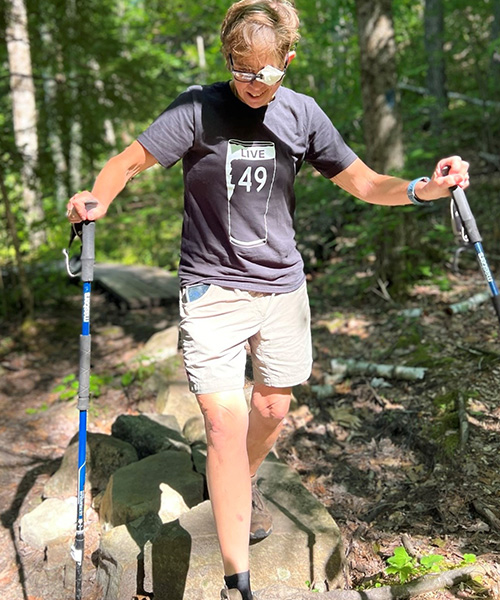
Sarah Dreshaj, pictured above, is a mother and business owner. She found her way to Brigham and Women’s Hospital after an MRI and CT scan found a tumor known as ‘clementine’ on the top of her spinal column. After arriving, she met with Dr. Arnaout who was eager and confident to perform surgery on the benign tumor. Sarah described Dr. Arnaout as being very open and truthful as he communicated the risk of surgery and positioning of the tumor. He encouraged Sarah to put trust into him and his team. Her experience was described as honest and respectful with all of her questions answered.
Dr. Arnaout finished her surgery in 32 hours, removing the entirety of the tumor and leading Sarah into a healthy recovery.
Sarah is an owner of The Dam Brewhouse, LLC a brewhouse located in Campton, NH. She describes it as a 3-barrell, small place where people can come together, meet people, and make friends. They have 10 beers on tap with flavors that are different and constantly changing. During a visit with Dr. Arnaout, joked in asking if she could make a special beer for the BWH team. They decided it should be an IPA that wasn’t too bitter or high in alcohol, with the name unknown. Following Sarah’s surgery it was agreed that the name of the beer would be 32 hours, honoring her surgery and the amount of time it took to complete. They had a release party on the first day that the beer was available, inviting doctors and nurses from the local area that were a part of her journey, as well as inviting Dr. Arnaout and his team to the brewhouse.
Sarah is one year out from surgery, she is still recovering and healing, but overall healthy and happy. Her advice to others going through surgery or a tough diagnosis is to have faith, trust in the technology and the doctors, and to be open with your family members.
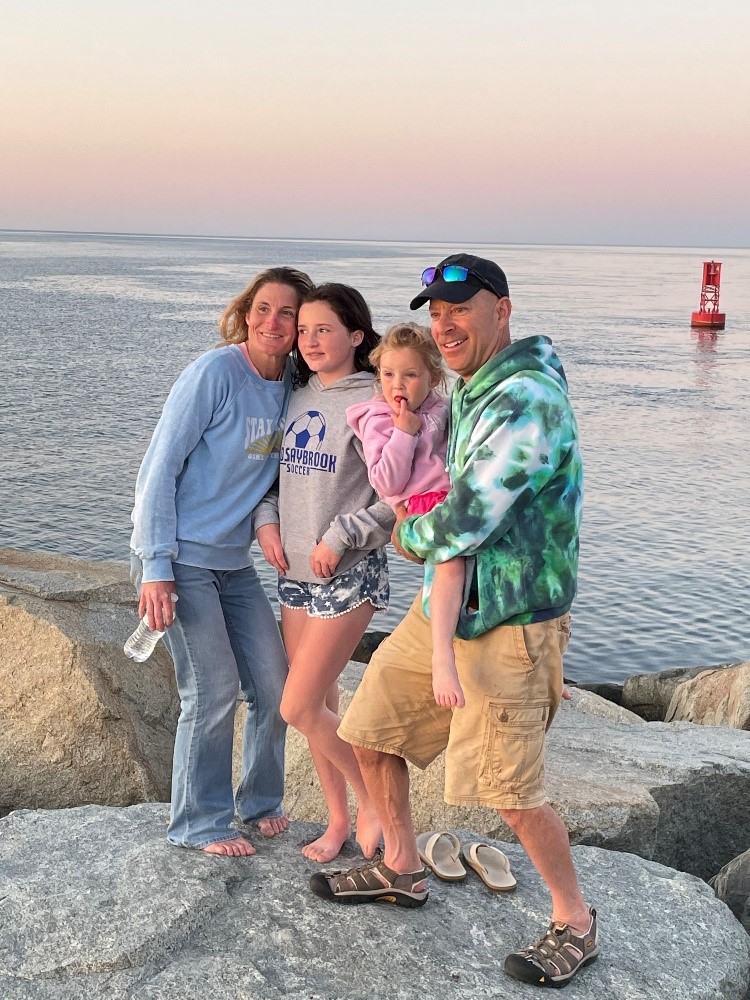
James (Jim) Wierzbicki (pictured above with his family) is a husband and father who found himself envisioning the things that he wanted to do with his family. After years of excruciating pain and great resistance to surgery, Jim and his wife met with Dr. Michael W. Groff, Vice Chair of the Neurosurgery Department, who made them feel very comfortable and “certainly never overpromised anything.”
Jim had a lumbar fusion surgery to join two or more bones in January by Dr. Groff and his team. In the procedure, two or more spinal bones are fused together to stabilize the spine and stop the movement between bones that is causing pain. Jim’s experience consisted of a 2-hour preop period that felt like 15 minutes because, “Dr. Groff and his team were fun and kept it alive.” 2 weeks post-surgery James states, “the way I feel now is exponentially better,” and couldn’t believe that he was able to feel his legs immediately after surgery.
Jim’s wife was able to stay the whole time with him while recovering and noted that “the food was fantastic, and the nursing staff was amazing on the 16th floor.” “I have a lot of life left,” Jim explained, as he discussed his experience and how incredibly thankful he was to Dr. Groff and his team. He was amazed at how long he had put surgery off because of the magnitude of the operation. Jim says that the biggest preventative factor for him before surgery was the fear factor of undergoing a procedure and he would like to share with anyone currently experiencing fear of surgery that “the outcome is life-changing.”
For over a century, a leader in patient care, medical education and research, with expertise in virtually every specialty of medicine and surgery.
About BWH